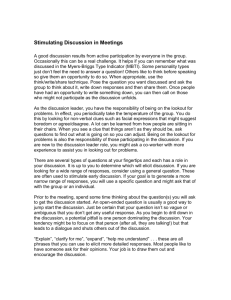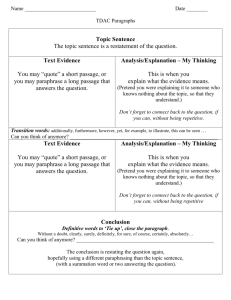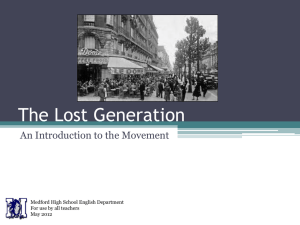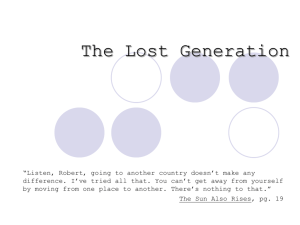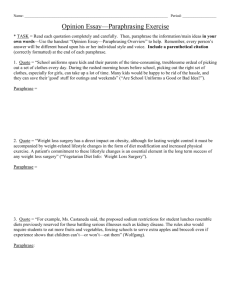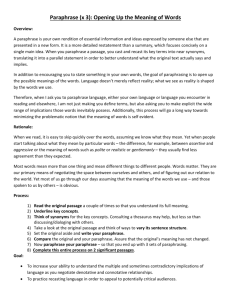Summarize, Paraphrase, or Quote?
advertisement
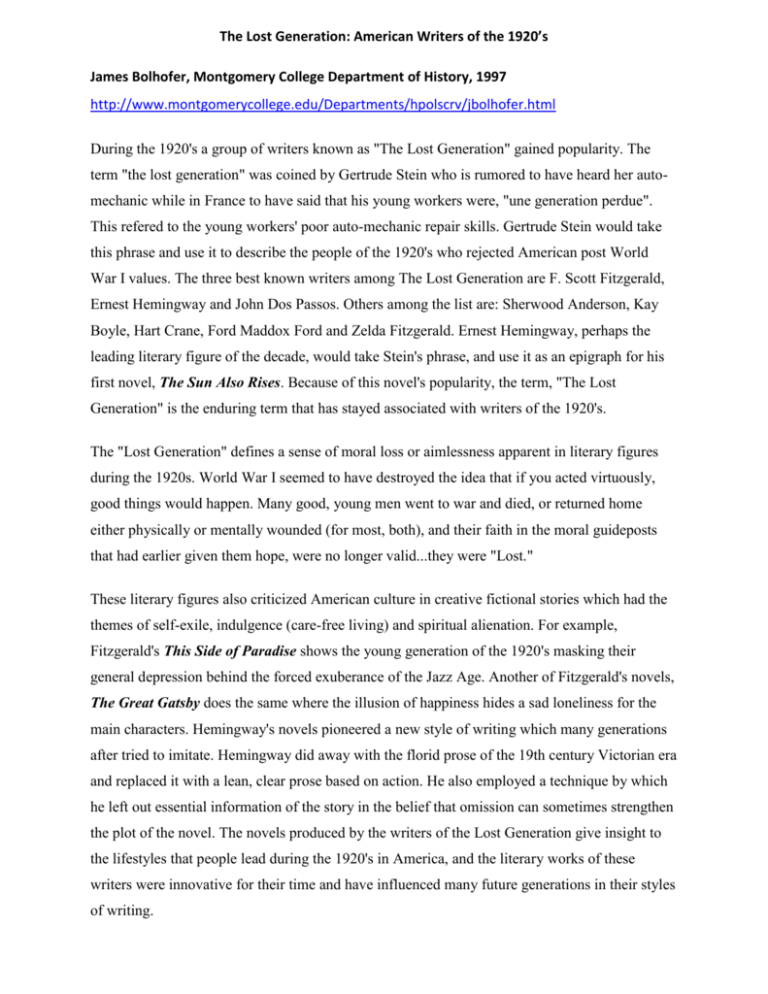
The Lost Generation: American Writers of the 1920’s James Bolhofer, Montgomery College Department of History, 1997 http://www.montgomerycollege.edu/Departments/hpolscrv/jbolhofer.html During the 1920's a group of writers known as "The Lost Generation" gained popularity. The term "the lost generation" was coined by Gertrude Stein who is rumored to have heard her automechanic while in France to have said that his young workers were, "une generation perdue". This refered to the young workers' poor auto-mechanic repair skills. Gertrude Stein would take this phrase and use it to describe the people of the 1920's who rejected American post World War I values. The three best known writers among The Lost Generation are F. Scott Fitzgerald, Ernest Hemingway and John Dos Passos. Others among the list are: Sherwood Anderson, Kay Boyle, Hart Crane, Ford Maddox Ford and Zelda Fitzgerald. Ernest Hemingway, perhaps the leading literary figure of the decade, would take Stein's phrase, and use it as an epigraph for his first novel, The Sun Also Rises. Because of this novel's popularity, the term, "The Lost Generation" is the enduring term that has stayed associated with writers of the 1920's. The "Lost Generation" defines a sense of moral loss or aimlessness apparent in literary figures during the 1920s. World War I seemed to have destroyed the idea that if you acted virtuously, good things would happen. Many good, young men went to war and died, or returned home either physically or mentally wounded (for most, both), and their faith in the moral guideposts that had earlier given them hope, were no longer valid...they were "Lost." These literary figures also criticized American culture in creative fictional stories which had the themes of self-exile, indulgence (care-free living) and spiritual alienation. For example, Fitzgerald's This Side of Paradise shows the young generation of the 1920's masking their general depression behind the forced exuberance of the Jazz Age. Another of Fitzgerald's novels, The Great Gatsby does the same where the illusion of happiness hides a sad loneliness for the main characters. Hemingway's novels pioneered a new style of writing which many generations after tried to imitate. Hemingway did away with the florid prose of the 19th century Victorian era and replaced it with a lean, clear prose based on action. He also employed a technique by which he left out essential information of the story in the belief that omission can sometimes strengthen the plot of the novel. The novels produced by the writers of the Lost Generation give insight to the lifestyles that people lead during the 1920's in America, and the literary works of these writers were innovative for their time and have influenced many future generations in their styles of writing. Taking Notes-Practice 1. First, evaluate the reliability and credibility of the source. Who wrote this article? What is their position? What motivation did they have for writing it? Could they be biased because of their position? If your source is clearly too biased (unless you are using it to persuade), or the author is not credible, find a more appropriate source of information. In general, Wikipedia and novel summary or theme summary sites such as Spark Notes are not reliable sources of information. Look for quality! 2. Begin by reading the article carefully. Highlight or underline, and make comments in the margins that point to topics covered in the article. 3. After reading and highlighting, briefly summarize the ideas of the article. 4. Look over the article and your notes and try to identify the Thesis, or single main idea that the author is trying to express in the article. 5. If the article causes you to have questions about what additional information you need to know about this topic, write those down to guide further research. 6. Transfer what you believe are the most important ideas and facts in the form of summaries, paraphrased material, and quotes from the article to your Note Taking Guide (see p.3- “Summarize, Paraphrase, or Quote”), or if you are doing a research paper, directly to your note cards. You can also use the Cornel Notes Method ( see p. 4) as well. 7. Look over your notes and the article and make sure you have collected all the important facts and information. 8. Repeat this process with every article. Summarize, Paraphrase, or Quote? A summary is a relatively brief, objective account, in your own words, of the main ideas in a source passage. Summarize to: To condense the material. You may have to condense or to reduce the source material to draw out the points that relate to your paper. To omit extras from the material. You may have to omit extra information from the source material to focus on the author’s main points. To simplify the material. You may have to simplify the most important complex arguments, sentences, or vocabulary in the source material. A paraphrase is a restatement, in your own words, of a passage of text. Its structure reflects the structure of the source passage. Paraphrases are sometimes the same length as the source passage, sometimes shorter. In certain cases-particularly if the source passage is difficult to read--the paraphrase may be even longer than the original. . . . Keep in mind that only an occasional word (but not whole phrases) from the original source appears in the paraphrase, and that a paraphrase's sentence structure does not reflect that of the source. Paraphrase to: To change the organization of ideas for emphasis. You may have to change the organization of ideas in source material so that you can emphasize the points that are most related to your paper. You should remember to be faithful to the meaning of the source. To simplify the material. You may have to simplify complex arguments, sentences, or vocabulary. To clarify the material. You may have to clarify technical passages or specialized information into language that is appropriate for your audience. A quotation uses the exact words of the original. Use Quotes to: 1. Accuracy: You are unable to paraphrase or summarize the source material without changing the author’s intent. 2. Authority: You may want to use a quote to lend expert authority for your assertion or to provide source material for analysis. 3. Conciseness: Your attempts to paraphrase or summarize are awkward or much longer than the source material. 4. Unforgettable language: You believe that the words of the author are memorable or remarkable because of their effectiveness or historical flavor. Additionally, the author may have used a unique phrase or sentence, and you want to comment on words or phrases themselves.


